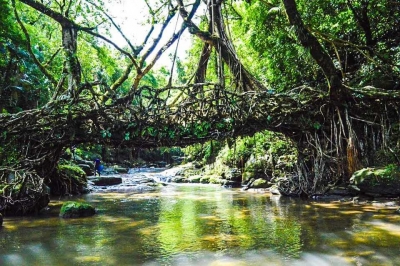
Mawlynnong made an appearance on the travel itineraries of people for the first time in 2003, when travel magazine Discover India declared it the “Cleanest Village” in Asia. The road from Shillong to Mawlynnong passes through such diverse terrain that it takes time for one to come to terms with the fact that you are still within the geographical bounds of the same state.
There are a number of living root bridges across the state, most of which can be reached by undertaking a long trek. These formations are unique to the state of Meghalaya. The most easily accessible of these is the Living Root Bridge, located in the neigh-bouring village of Riwai.
This hamlet is only a couple of minutes away from Mawlynnong, and has found its way on the tourist map because of the spectacular living root bridges. As you enter Riwai, a small clearing serves as a parking lot, and it is surrounded by many eateries selling local dishes. A paved road takes you to the ticket counter.
Set in verdant environs, this single-decker bridge at Riwai spans over a gushing stream peppered with rocks. The living bridge was fashioned from the roots of the rubber fig tree by the Khasi villagers in order to cross over the stream. Such root bridges become stronger with time, and take 10 to 15 years to become fully functional. The bridges are, however, strong enough to hold the weight of upto 50 people at a time. Visitors can even descend to the stream below and take a dip in the cool waters.
Picture Credit : Google

